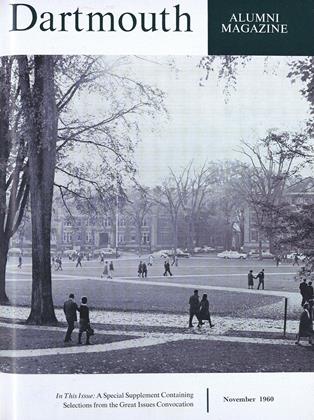Dartmouth has been the scene of many unusual scientific experiments, but none so unusual perhaps as that now taking place in the Hanover Frozen Food Locker. There a group of Dartmouth geologists, bundled in heavy coats, are experimenting with ice up to 3,500 years old.
The research is being conducted under a contract granted by the U. S. Air Force. It was under its sponsorship, together with the Defense Research Board of Canada, that an expedition earlier this year explored the Ward Hunt ice shelf, 300 miles from the North Pole.
Four Dartmouth men were included in the United States-Canadian expedition which set out last spring: Prof. John B. Lyons, M.A. '52, Professor of Geology at the College; Robert T. Blair '58, Richard H. Ragle, M.S. '58, and Frank Leavitt '56. The purpose of the expedition was to study the nature, origin and future history of the ice shelf in order to determine the practicability of establishing an airfield there.
Ice cores were obtained from various levels by hand drills. The samples ranged from less than an inch to more than thirty inches in length. The problem, however, was to transport the ice back to the United States. A year ago a similar effort to secure samples had failed because of melting.
This time the samples were wrapped in plastic liners and placed in aluminum-coated cardboard cylinders, three feet long and three inches in diameter. They were then nestled in snow in three huge wooden crates lined with plastic. By air and then by sea the crates were shipped to the United States. Now that the ice has reached Hanover, the research must be conducted under arctic conditions in a room where the temperature is always between zero and 15 degrees Fahrenheit, so as to avoid a change in crystal structure.
The U. S. Air Force has granted only two contracts for the ice experiments. One was given to Professor Lyons and the second to the Arctic Institute of North America in Montreal. Blair is acting as research assistant to Professor Lyons and Ragle as research scientist to the Arctic Institute. Blair and Ragle are working together in Hanover.
Several types of core analysis are being undertaken in order to determine the history and future of the ice shelf. First an optical examination is made to determine what type of ice makes up the shelf, firn, sea ice or lake ice. Then the ice layers will be studied to learn the age and rate of accumulation of the ice. Other tests will involve the use of a light table in order to break down the macro-features of the cores, and finally there will be a test to determine the bubble pressure of the ice.
For the U. S. Air Force this is another stage in its search for new landing fields in the far north. For Dartmouth it is a new area of basic research and another chance to help the country strengthen its defenses.
Robert T. Blair '58 (1), a research assistant in geology, and Richard Ragle M.S. '58 (r), a research scientist, examine a polar ice core believed to be nearly 3,500 years old.
 View Full Issue
View Full Issue
More From This Issue
-
 Feature
FeatureIt Was A Dartmouth Jinx All the Time
November 1960 By AMOS N. BLANDIN '18 -
 Feature
FeatureA Fulbright Year in France
November 1960 By FRANCIS E. MERRILL '26 -
 Feature
FeatureThe Commitment of Leadership
November 1960 By JOHN SLOAN DICKEY -
 Feature
Feature"The Era of the Shrug"
November 1960 -
 Article
ArticleEvening Assembly
November 1960 -
 Article
ArticleSecond Panel Discussion
November 1960







